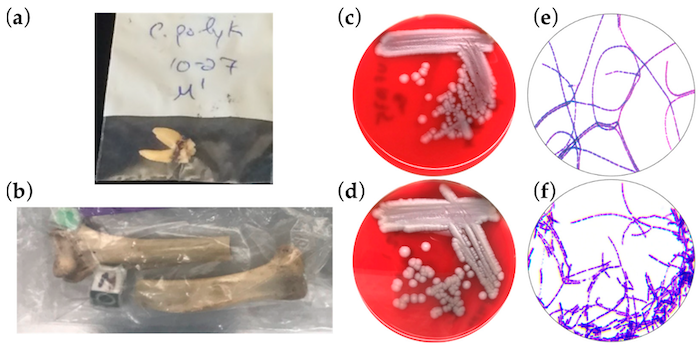
NORRIS, BLACKBURN – Genomic and Phylogenetic Analysis of Bacillus cereus Biovar anthracis Isolated from Archival Bone Samples Reveals Earlier Natural History of the Pathogen
Article first published online: 20 August 2023
DOI: https://doi.org/10.3390/pathogens12081065
ABSTRACT: Bacillus cereus biovar anthracis (Bcbva) was the causative agent of an anthrax-like fatal disease among wild chimpanzees in 2001 in Côte d’Ivoire. Before this, there had not been any description of an anthrax-like disease caused by typically avirulent Bacillus cereus. Genetic analysis found that B. cereus had acquired two anthrax-like plasmids, one a pXO1-like toxin producing plasmid and the other a pXO2-like plasmid encoding capsule. Bcbva caused animal fatalities in Cameroon, Democratic Republic of Congo, and the Central African Republic between 2004 and 2012. (2) Methods: The pathogen had acquired plasmids in the wild and that was discovered as the cause of widespread animal fatalities in the early 2000s. Primate bones had been shipped out of the endemic zone for anthropological studies prior to the realized danger of contamination with Bcbva. Spores were isolated from the bone fragments and positively identified as Bcbva. Strains were characterized by classical microbiological methods and qPCR. Four new Bcbva isolates were whole-genome sequenced. Chromosomal and plasmid phylogenomic analysis was performed to provide temporal and spatial context to these new strains and previously sequenced Bcbva. Tau and principal component analyses were utilized to identify genetic and spatial case patterns in the Taï National Park anthrax zone. (3) Results: Preliminary studies positively identified Bcbva presence in several archival bone fragments. The animals in question died between 1994 and 2010. Previously, the earliest archival strains of Bcbva were identified in 1996. Though the pathogen has a homogeneous genome, spatial analyses of a subset of mappable isolates from Taï National Park revealed strains found closer together were generally more similar, with strains from chimpanzees and duikers having the widest distribution. Ancestral strains were located mostly in the west of the park and had lower spatial clustering compared to more recent isolates, indicating a local increase in genetic diversity of Bcbva in the park over space and time. Global clustering analysis indicates patterns of genetic diversity and distance are shared between the ancestral and more recently isolated type strains. (4) Conclusions: Our strains have the potential to unveil historical genomic information not available elsewhere. This information sheds light on the evolution and emergence of a dangerous anthrax-causing pathogen.
Read the full publication in Pathogens.